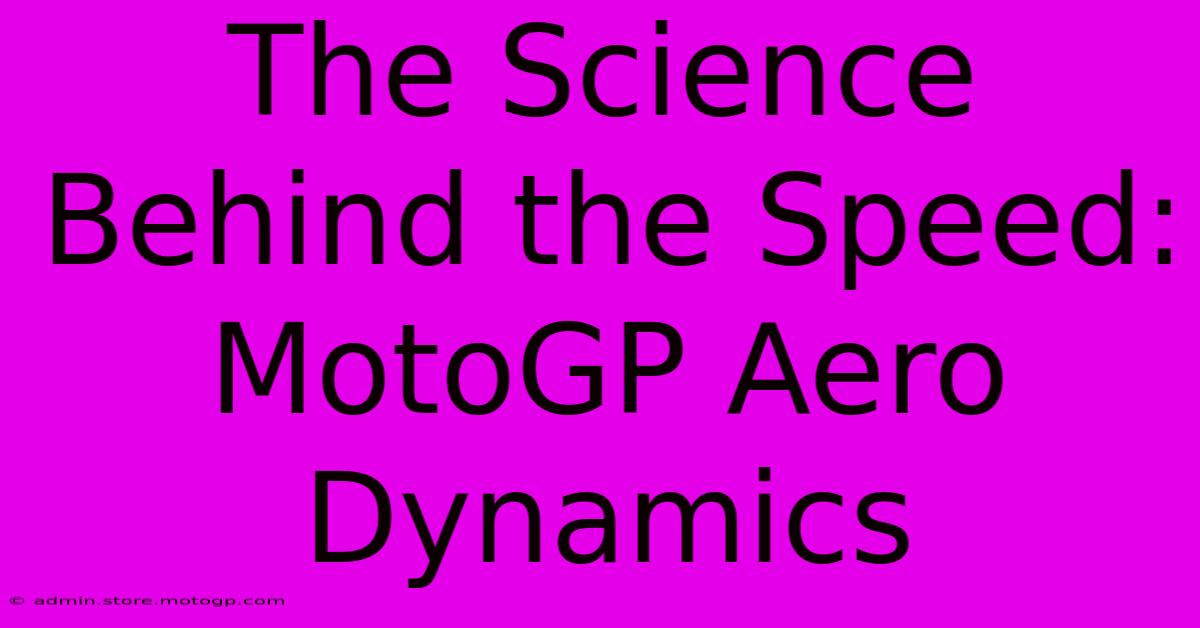The Science Behind The Speed: MotoGP Aero Dynamics

Table of Contents
The Science Behind the Speed: MotoGP Aerodynamics
MotoGP. The pinnacle of motorcycle racing. The roar of the engines, the breathtaking speeds, the nail-biting finishes – it's all captivating. But beyond the thrill of the race, there's a complex world of engineering and technology driving these incredible machines forward. And a significant part of that is aerodynamics. This isn't just about sleek design; it's a precise science that dictates lap times and, ultimately, championship victories. Let's delve into the fascinating world of MotoGP aerodynamics.
Understanding the Forces at Play
Before we dive into the specifics of MotoGP aero, let's establish the fundamental forces involved. At high speeds, a motorcycle experiences significant air resistance (drag), which slows it down. This drag increases exponentially with speed. To counteract this, MotoGP bikes utilize aerodynamic devices to generate downforce, pushing the bike towards the track surface. This increased grip allows for higher cornering speeds and improved stability under braking.
The Importance of Downforce
Downforce is crucial in MotoGP for several reasons:
- Increased Cornering Speed: More downforce means greater grip, allowing riders to lean further into corners without losing traction. This translates directly to faster lap times.
- Enhanced Braking Performance: With the bike firmly planted on the track, braking becomes more predictable and effective, reducing stopping distances.
- Improved Stability: Downforce helps maintain stability at high speeds, especially during acceleration and over bumps, preventing unsettling high-speed wobbles.
Aerodynamic Components in MotoGP
Modern MotoGP bikes are masterpieces of aerodynamic engineering, utilizing various components to optimize downforce and minimize drag. These include:
- Fairings: The main bodywork of the bike, meticulously sculpted to manage airflow and reduce drag. Even subtle changes to the fairing's shape can significantly impact performance.
- Wings: These are perhaps the most visually striking aerodynamic features. They generate downforce, particularly at the front of the bike, increasing stability and cornering speed. The design, angle, and size of these wings are constantly being refined.
- Underbody Aerodynamics: The airflow under the bike is just as important as the airflow over it. Careful shaping of the underbody helps to create a low-pressure zone, increasing downforce.
- Winglets: Smaller wings, often integrated into the fairing or other components, contribute to overall downforce and help manage airflow.
The Constant Evolution of MotoGP Aerodynamics
The quest for aerodynamic perfection is an ongoing process. Teams employ sophisticated Computational Fluid Dynamics (CFD) simulations and wind tunnel testing to refine designs and maximize performance. Every tiny adjustment—a slight change in wing angle, a modification to the fairing shape—can yield measurable improvements in lap times.
The Role of Data and Technology
Data acquisition and analysis are integral to MotoGP aerodynamics. Teams collect vast amounts of data during testing and races, analyzing airflow patterns, pressure distribution, and other parameters to optimize their designs. This data-driven approach is critical in pushing the boundaries of aerodynamic performance.
The Future of Aerodynamics in MotoGP
The future of MotoGP aerodynamics promises further innovation. We can expect to see even more sophisticated designs, potentially incorporating active aerodynamic systems that adapt in real-time to changing track conditions and rider input. The relentless pursuit of speed, driven by cutting-edge technology and scientific understanding, ensures that the sport will continue to be a showcase of engineering excellence.
Keywords: MotoGP, Aerodynamics, Downforce, Drag, MotoGP Bikes, Wings, Fairings, Winglets, Wind Tunnel Testing, CFD, Computational Fluid Dynamics, Motorcycle Racing, Racing Technology, High-Speed Stability, Cornering Speed, Braking Performance, Aerodynamic Components
This article provides a comprehensive overview of MotoGP aerodynamics, incorporating various SEO best practices including keyword optimization, structural elements (headings, bullet points), and a focus on readability to improve user engagement and search engine ranking.

Thank you for visiting our website wich cover about The Science Behind The Speed: MotoGP Aero Dynamics. We hope the information provided has been useful to you. Feel free to contact us if you have any questions or need further assistance. See you next time and dont miss to bookmark.
Featured Posts
-
The Unsung Heroes Of Moto Gp The Announcers
Feb 18, 2025
-
F1 Qualifying Today Analyzing The Lap Times
Feb 18, 2025
-
The Ultimate Cota Parking Hack Your Map
Feb 18, 2025
-
Austin Motorcycle Race A Festival Of Speed
Feb 18, 2025
-
Cota Qualifying Conquer Your Fears Conquer The Track
Feb 18, 2025
